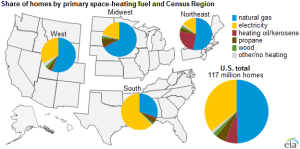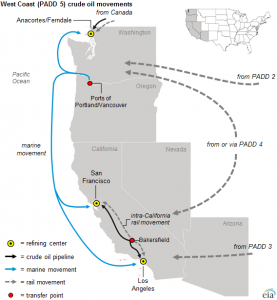New Classifications of Natural Gas Storage Regions Begin this Week

Natural gas storage levels have been high recently, reaching a record 3,978 Tcf as of Nov. 6. In an effort to better illustrate regional storage trends, EIA will publish weekly data divided into five regions, rather than the current three, beginning with the Nov. 19 report.
When the WNGSR was originally established in 1993 by the American Gas Association (AGA), data for the Lower 48 states were separated into three groups: the Consuming East, the Consuming West, and the Producing region. At the time, the Producing region (including Gulf of Mexico offshore) was home to 74% of the nation’s natural gas production, while the other regions were generally consumers.
Because of changes in regional trends in natural gas consumption, production, and storage, the new categorization generally splits each of the previous two consuming regions into two parts, while the coverage of the former Producing region is now largely encompassed by the South Central region.
With a few exceptions, the states previously grouped as the Consuming East region are now in two groups: the Midwest and the East. The main difference in the two regions is the type of storage facilities. The Midwest region with its high concentration of aquifers has more than 85% of all natural gas storage aquifers in the nation.
This type of field tends to have only one cycle per year – they are filled with natural gas during summer and fall, and then the stored natural gas is withdrawn through winter and spring. Facilities in the Midwest tend to inject natural gas at much more consistent volumes compared to the East, reflecting the more stable and predictable behavior of aquifers.
Storage facilities in the East region, by contrast, consist almost entirely of depleted fields. Depleted fields generally offer a higher degree of flexibility to inject or withdraw gas at any given time compared to aquifers, and as a result, net movements of gas into and out of storage in the East region show more variability than those in the Midwest.
The previous West region was split into two regions, the Pacific and Mountain regions. Although both the new Pacific and Mountain regions are dominated by storage in depleted fields, the Pacific region facilities tend to have much higher deliverability – meaning gas is able to be withdrawn at higher rates.
Average deliverability of fields in the Pacific is close to 0.5 Bcf/d, which is nearly three times higher than that of the Mountain region, even though average working gas capacity is roughly the same in the two regions. Many facilities in the Pacific region use storage in an active way to respond to price conditions and customer demand, similar to how salt facilities might operate.
With the exception of New Mexico, which is now in the Mountain region, the Producing region has remained relatively unchanged, but it was renamed the South Central region. The South Central region is home to most of the U.S. salt dome storage facilities, which are able to cycle gas much more rapidly than either depleted fields or aquifer storage.
Because the nature and operation of salt facilities are distinct from depleted reservoir facilities, the South Central region can be further separated into salt and nonsalt, as was the previous Producing region. EIA began publishing separate salt and nonsalt data in 2012, and backcast the series to the end of 2006.
Principal contributor: Michael Kopalek


Related News
Related News

- Kinder Morgan Proposes 290-Mile Gas Pipeline Expansion Spanning Three States
- Enbridge Plans 86-Mile Pipeline Expansion, Bringing 850 Workers to Northern B.C.
- Intensity, Rainbow Energy to Build 344-Mile Gas Pipeline Across North Dakota
- Tallgrass to Build New Permian-to-Rockies Pipeline, Targets 2028 Startup with 2.4 Bcf Capacity
- U.S. Moves to Block Enterprise Products’ Exports to China Over Security Risk
- U.S. Pipeline Expansion to Add 99 Bcf/d, Mostly for LNG Export, Report Finds
- A Systematic Approach To Ensuring Pipeline Integrity
- 275-Mile Texas-to-Oklahoma Gas Pipeline Enters Open Season
- US Poised to Become Net Exporter of Crude Oil in 2023
- EIG’s MidOcean Energy Acquires 20% Stake in Peru LNG, Including 254-Mile Pipeline




Comments